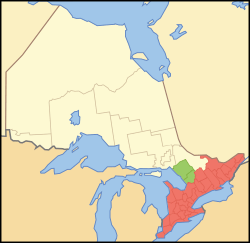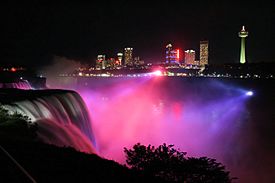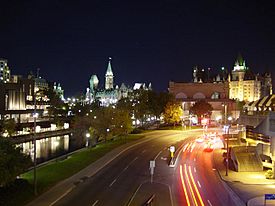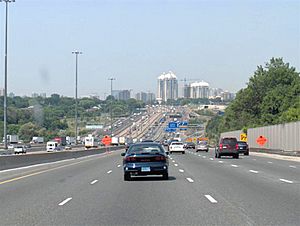Southern Ontario facts for kids
Quick facts for kids
Southern Ontario
|
|
|---|---|
|
Primary region
|
|
| Southern Ontario | |

██ Core area ██ Extended area |
|
| Country | |
| Province | |
| Area | |
| • Total | 114,217 km2 (44,099 sq mi) |
| • Core area | 101,264 km2 (39,098 sq mi) |
| • Extended area | 12,953 km2 (5,001 sq mi) |
| Population
(2021)
|
|
| • Total | 13,481,332 |
| • Density | 118.0/km2 (306/sq mi) |
| • Core area | 13,367,749 |
| • Extended area | 113,583 |
| Demonym(s) | Southern Ontarian |
| Time zone | UTC−5 (EST) |
| • Summer (DST) | UTC−4 (EDT) |
| Postal code prefixes |
K, L, M, N
|
| Area code(s) | 226, 249, 289, 343, 365, 416, 437, 519, 548, 613, 647, 705, 905 |
Southern Ontario is a major region in the Canadian province of Ontario. It is the most populated and southernmost part of Canada. About 13.5 million people live here, which is around 36% of Canada's total population.
This region is located south of Northern Ontario, the province's other main area. Southern Ontario is very different from Northern Ontario. It has many more people, a different climate, and a unique culture. It is divided into smaller areas like Central Ontario, Eastern Ontario, the Golden Horseshoe, and Southwestern Ontario. The main part of Southern Ontario is also part of the Quebec City–Windsor Corridor, a busy area that stretches into southern Quebec.
Contents
- Understanding Southern Ontario
- A Look at Southern Ontario's Past
- Who Lives in Southern Ontario?
- Southern Ontario's Economy
- Fun Things to Do in Southern Ontario
- Major Cities in Southern Ontario
- Higher Education in Southern Ontario
- Culture and People
- Getting Around Southern Ontario
- Southern Ontario's Climate
Understanding Southern Ontario
Southern Ontario stands out from Northern Ontario because it has a much larger population. Most of Ontario's cities, main roads, and important buildings are found here. Northern Ontario, on the other hand, has more natural resources and wild areas.
Even though Southern Ontario doesn't have an ocean coastline, it has lots of freshwater shorelines. These are on three of the Great Lakes: Lake Huron, Lake Erie, and Lake Ontario. There are also smaller lakes like Lake Simcoe and Lake St. Clair. This region is also a big area for growing grapes and making Canadian wines.
Southern Ontario has been part of the province of Ontario since 1867. Before that, it was known as the colony of Upper Canada. A large part of Northern Ontario only became part of the province much later, in 1912.
A Look at Southern Ontario's Past

In the 1600s, French explorers came to what is now Southern Ontario. They built relationships with the Wyandot (Huron) people, who lived near Georgian Bay and Lake Simcoe. Other Indigenous groups, like the Petun and Neutral Nation, lived to the south. Algonquins lived near the Ottawa River, and the Mississaugas moved south from Lake Huron.
After the Seven Years' War, the British took control of Southern Ontario. More people started to settle here, especially after the American Revolution. Many United Empire Loyalists, who were loyal to Britain, moved here from the United States.
Southern Ontario was a key location for many battles during the War of 1812. It was also an important destination for enslaved people seeking freedom through the Underground Railroad.
Who Lives in Southern Ontario?
Southern Ontario is home to over 94% of Ontario's total population. This means about 12.1 million people live here, compared to only about 750,000 in Northern Ontario. Many things explain this difference. The south has better land for farming and a milder climate. It also has good ways to travel by water, land, and air. Plus, European settlers arrived here very early.
For thousands of years, Southern Ontario has been home to Indigenous communities. Many different nations with their own languages lived here when Europeans first arrived. Today, over 200,000 Indigenous Canadians live in Southern Ontario.
The region was first settled by the French and then the British. After the American Revolutionary War, more European immigrants came. Even more arrived in the late 1800s and early 1900s. Since the late 20th century, many immigrants have come from Asia and other parts of the world. Southern Ontario, especially the Greater Toronto Area, is one of the most popular places for immigrants to move.
Southern Ontario's Economy
This area has a large manufacturing industry. Since the mid-2000s, Ontario has made more vehicles each year than the state of Michigan in the U.S. However, some cities in the south have faced challenges. Many factories have closed due to changes in industry and jobs moving overseas. This has affected cities like Windsor, London, St. Thomas, and St. Catharines.
Hamilton is a center for steel production, and Sarnia is known for making chemicals from oil. These cities have also been affected, but less severely. Toronto and Ottawa, the province's two largest cities, have shifted more towards service and knowledge-based jobs. Toronto is Canada's financial hub, home to major banks and the Toronto Stock Exchange. Ottawa, as the national capital, is where the Government of Canada is located. It also has a strong technology industry.
Some parts of Southern Ontario are closely connected to nearby U.S. cities like Buffalo in New York and Detroit in Michigan. Many people live and work on opposite sides of the border. The NEXUS program helps people who cross the border often. Southern Ontario also trades a lot with Montreal and the province of Quebec, as well as parts of northern Ohio and western Pennsylvania.
Most of Ontario's farming happens here. This includes many berry farms, represented by Ontario Berries.
Fun Things to Do in Southern Ontario
Southern Ontario is famous for its many attractions and tourism. Some popular places to visit include the CN Tower, Parliament Hill, Niagara Falls, and Canada's Wonderland. Other attractions are the Toronto Zoo, Hockey Hall of Fame, and the Royal Ontario Museum.
Niagara Falls is one of the most visited attractions in the world, with over 14 million tourists each year. In 2006, Toronto was the 14th most visited city by international tourists. Ottawa is the most visited city in Canada by Canadian tourists.
Southern Ontario is home to several professional sports teams. These include the Ottawa Senators and Toronto Maple Leafs (hockey), the Toronto Blue Jays (baseball), and the Toronto Raptors (basketball). There are also soccer teams like Toronto FC and Atlético Ottawa, and three Canadian Football League teams. The region also hosts major golf and tennis tournaments.
The area hosts many famous festivals and events. These include the Toronto International Film Festival, Winterlude, Caribana, and Kitchener Oktoberfest.
There are also several large legal gambling places, like Caesars Windsor and Fallsview Casino. The Ontario Lottery and Gaming Corporation (OLG) oversees all gambling in the province.
Southern Ontario has many beautiful natural spots. Wasaga Beach, Grand Bend, Sauble Beach, and Sandbanks are popular beaches along the Great Lakes. The Niagara Escarpment is great for hiking and skiing, and it has hundreds of waterfalls, including Niagara Falls. The Ottawa River is famous for white-water rafting. Ontario Parks manages provincial parks, and Parks Canada manages national parks.
Major Cities in Southern Ontario
Southern Ontario is home to both Canada's capital city, Ottawa, and Canada's largest city, Toronto.
The region's communities use many different telephone area codes. These include 226, 249, 289, 343, 365, 382, 416, 437, 519, 548, 613, 647, 705, and 905.
Statistics Canada groups cities and their nearby "commuter" towns into what they call a "Census Metropolitan Area" (CMA). This helps measure the total population of a city and its surrounding area.
| Southern Ontario Cities † | 2021 Population | 2016 Population |
|---|---|---|
| Toronto CMA | 6,202,225 | 5,928,040 |
| Ottawa CMA | 1,488,307 | 1,323,783 |
| Hamilton CMA | 785,184 | 747,545 |
| Kitchener–Cambridge–Waterloo CMA | 575,847 | 523,894 |
| London CMA | 543,551 | 494,069 |
| St. Catharines–Niagara CMA | 433,604 | 406,074 |
| Windsor CMA | 422,630 | 398,718 |
| Oshawa CMA | 415,311 | 379,848 |
Higher Education in Southern Ontario
Southern Ontario has long been a popular place for students to get a higher education. It has many well-known public universities and colleges. There are 13 universities and 20 colleges. The region also has many private post-secondary schools.
Culture and People
Many famous Canadians have come from Southern Ontario, as it is the most populated area in Canada. Toronto is especially known for its multiculturalism and diverse population. Southern Ontario also plays a role in a type of Canadian literature called Southern Ontario Gothic.
Getting Around Southern Ontario

Southern Ontario has a very well-developed transportation system. This includes many highways, airports, ports, trains, and buses. The main highways are called the King's highways or the 400 series highways. All major highways in Ontario have at least four lanes and are divided. Key highways include the 401, 400, and the Queen Elizabeth Way.
Southern Ontario also has several border crossings with the United States. Bridges and tunnels connect the region to Michigan and New York.
The region has a long history of water transportation. Hundreds of millions of tons of goods move along the Great Lakes and Saint Lawrence Seaway each year. The Welland Canal is very important because it allows ships to bypass Niagara Falls. Major ports include the Port of Hamilton and Port of Windsor. Southern Ontario also has thousands of other freshwater lakes and rivers, as well as the Trent-Severn Waterway and Rideau Canal.
Train service between cities is mainly provided by Via Rail. The Greater Toronto area also has a commuter train system called the GO Train, which has many bus routes too.
There are several major international airports here. These include Toronto Pearson International Airport, which is the busiest in Canada. Other airports are Ottawa Macdonald–Cartier International Airport and John C. Munro Hamilton International Airport. Many people living near the U.S. border also use airports in Detroit or Buffalo.
Southern Ontario's Climate
Southern Ontario has a humid continental climate with four clear seasons. In July, the average high temperatures are between 25 and 29 °C (77 and 84 °F). In January, the average high temperatures are between -6 and 0 °C (21 and 32 °F). The warmest temperature ever recorded in Southern Ontario was 45 °C (113 °F), feeling even hotter with humidity. During very cold periods, winter temperatures can sometimes drop below -30 °C (-22 °F). The climate here is much milder than in Northern Ontario. This is because of its lower latitude, the nearby Great Lakes, and many cities.
Strong weather can happen in the region. In summer, Southern Ontario can get tornadoes, strong winds, hail, and local flooding from thunderstorms. While most tornadoes don't cause much damage, very strong ones (like F4) can happen every few decades. Southern Ontario can also experience leftover hurricanes, floods, ice storms, heavy fog, hail, and blizzards.
Small earthquakes also occur here. For example, a 5.8 magnitude earthquake happened in 1944.
Many tourists visit in the autumn to see the bright, colorful fall leaves.
Southern Ontario's climate is quite different from the rest of Canada. It is the only area in Canada that has Carolinian forest. Many trees, plants, and animals found here are not seen anywhere else in the country. Some rare trees include the tulip tree and the pawpaw fruit tree. Sadly, much of the original Carolinian forests have been lost due to development.
The region has the most freshwater beaches in Canada. These beaches have white sand and relatively warm waters by mid-summer. Millions of tourists visit popular beaches like Wasaga Beach and Grand Bend every summer.






